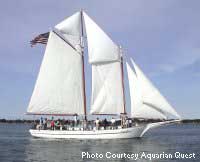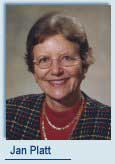FWRI Asks For Fish Tales
Scientists at the Florida Fish and Wildlife Research Institute (FFWRI) in St. Petersburg are asking offshore anglers for information that will help identify fishing trends. The survey, located at: www.research.myfwc.com/wahoo asks general questions about offshore fishing as well as specific inquiries about wahoo.
Wahoo, related to mackerals, are among the fastest pelagic species, reaching speeds of up to 50 miles per hour, and are prized game fish for their fighting qualities and excellent flavor.
They are the topic of several ongoing studies at FWRI and Florida Atlantic University and are thought to be relatively fast-growing fish. One tagged wahoo had gained 22 pounds when it was caught less than a year later. The largest wahoo every caught on hook and line was 158 pounds, but uncertified reports indicate they may grow as big as 200 pounds.
For more information about the survey or research, email wahoo@myfwc.com.

Aquarian Quest Returns to Tampa BayAquarian Quest, the 73-foot replica of a Gulf Coast schooner, has returned to Sarasota for the winter and is scheduling three-hour sailing fieldtrip adventures from November through May, including trips from Tampa Bay ports.
The trips, open to students in grades three to 12 as well as adults, feature four onboard learning stations that teach ageappropriate lessons on wildlife, navigation and water quality. Cost is $695 for up to 40 students with three adult chaperones.
For more information, visit www.aquarianquest.org. or call Bob Killian at 941-587-9313.
|

Aquarian Quest offers three-hours educational trips for students and adults.
|

Southshore Habitat Restoration Expands with New Funds
An $8,000 grant from the Tampa Port Authority will help build about 20 new demonstration sites for artificial reefs in Apollo Beach and Ruskin. The funding follows a $5000 grant from the Tampa Bay Estuary Program that resulted in 15 demonstration sites in Southshore area of eastern Tampa Bay.
The artificial reefs are designed to create habitat along barren seawalls, said Gus Muench, a commercial crabber for 25 years who also has served as president of the Little Manatee Preservation Committee. Four-foot polyethylene tubes host hundreds of tiny animals almost from the very start. As the reef grows, oysters, shrimp and small fish attract larger fish that bring in the birds. Over time, mangroves put down roots and provide homes for more birds and crabs.
The reefs will be installed at no charge to waterfront homeowners and participants may become eligible for cash awards presented annually through the Southshore Diamond Habitat Awards Program. For more information, email Muench at baychopgus@tampabay.rr.com or call 813-645-6063.

Corps Narrows Alternatives for Channel Widening
The US Army Corps of Engineers has narrowed options for improving the Tampa Bay ship channel from up to 18 combinations to five, eliminating all alternatives except widening the 40-mile channel in the spots deemed most dangerous.
The cost for other options, including a loop channel and anchorage area, exceeded anticipated benefits, said Mark Wolff, Corps technical leader for the Tampa and St. Petersburg projects. “The remaining alternatives are more manageable and cost-effective,” he said.
Selecting the smaller projects also will minimize environmental impacts, added Bill Fonferek, biologist for the Corps. “It appears that the impact may not be as severe as some people may have thought.”
All options will initially be compared using costs for offshore disposal of dredge materials, but the Corps remains committed to looking for cost-effective beneficial uses for the material, Fonferek added.
|
|
| |
Platt Honored with Ethics Award
 Former Hillsborough County Commissioner and long-time bay activist Jan Platt received the 2005 Tampa Bay Ethics Award at a University of Tampa breakfast on September 23. Former Hillsborough County Commissioner and long-time bay activist Jan Platt received the 2005 Tampa Bay Ethics Award at a University of Tampa breakfast on September 23.
Since 1991, the UT Center for Ethics has recognized an individual whose personal, business and professional life reflects those classical ethical standards that contribute to all that is good in society – responsibility, respect, trustworthiness, caring, justice and citizenship. Platt was noted for her integrity during 24 years as a Hillsborough County Commissioner. In addition to chairing the county commission, the Tampa Bay Regional Planning Council and Hillsborough County’s Environmental Protection Commission, she also served on the Tampa City Council, Hillsborough County Expressway Authority and Criminal Justice Board. She currently chairs the County Charter Review Board.
Platt was one of the founding forces behind the Tampa Bay Regional Planning Council’s Agency on Bay Management in 1985, which successfully lobbied for Tampa Bay’s nomination into the National Estuary Program and for establishment of the state surface water improvement and management (SWIM) program. She remains active in ABM and as a champion for numerous other community organizations including the Tampa Museum of Art, Suncoast Girl Scouts Council, and Head Start.
NOAA/AFS Recognizes Clark For Habitat Conservation
 Peter Clark, founder of the Tampa Bay Watch environmental stewardship program, has been awarded the Dr. Nancy Foster Habitat Conservation Award for initiating innovative, sustained conservation projects and programs and encouraging the Tampa Bay community to become stewards of the bay’s wetland habitats. Peter Clark, founder of the Tampa Bay Watch environmental stewardship program, has been awarded the Dr. Nancy Foster Habitat Conservation Award for initiating innovative, sustained conservation projects and programs and encouraging the Tampa Bay community to become stewards of the bay’s wetland habitats.
Established in 1997 by the National Oceanic and Atmospheric Administration’s Fisheries Office of Habitat Conservation and the American Fisheries Society’s Estuaries Section, the award was presented to Clark at the AFS conference in Anchorage.
“This award recognizes more than my personal accomplishments. It is a nod to Tampa Bay Watch, our staff, our volunteers and everyone who supports our community-based programs,” said Clark.
Since 1993, Tampa Bay Watch has coordinated more than 30,000 volunteers, installed 2,667 oyster reef units, built more than 90 oyster bars and 60 acres of coastal tidal marsh and removed more than 60 tons of debris. Tampa Bay Watch will open a new education and marine center in Tierra Verde to house the organization’s offices and serve as a coastal classroom for students in a new environmental curriculum.
Prior to founding Tampa Bay Watch, Clark was director of the Tampa Bay Regional Planning Council’s Agency on Bay Management.
|
|